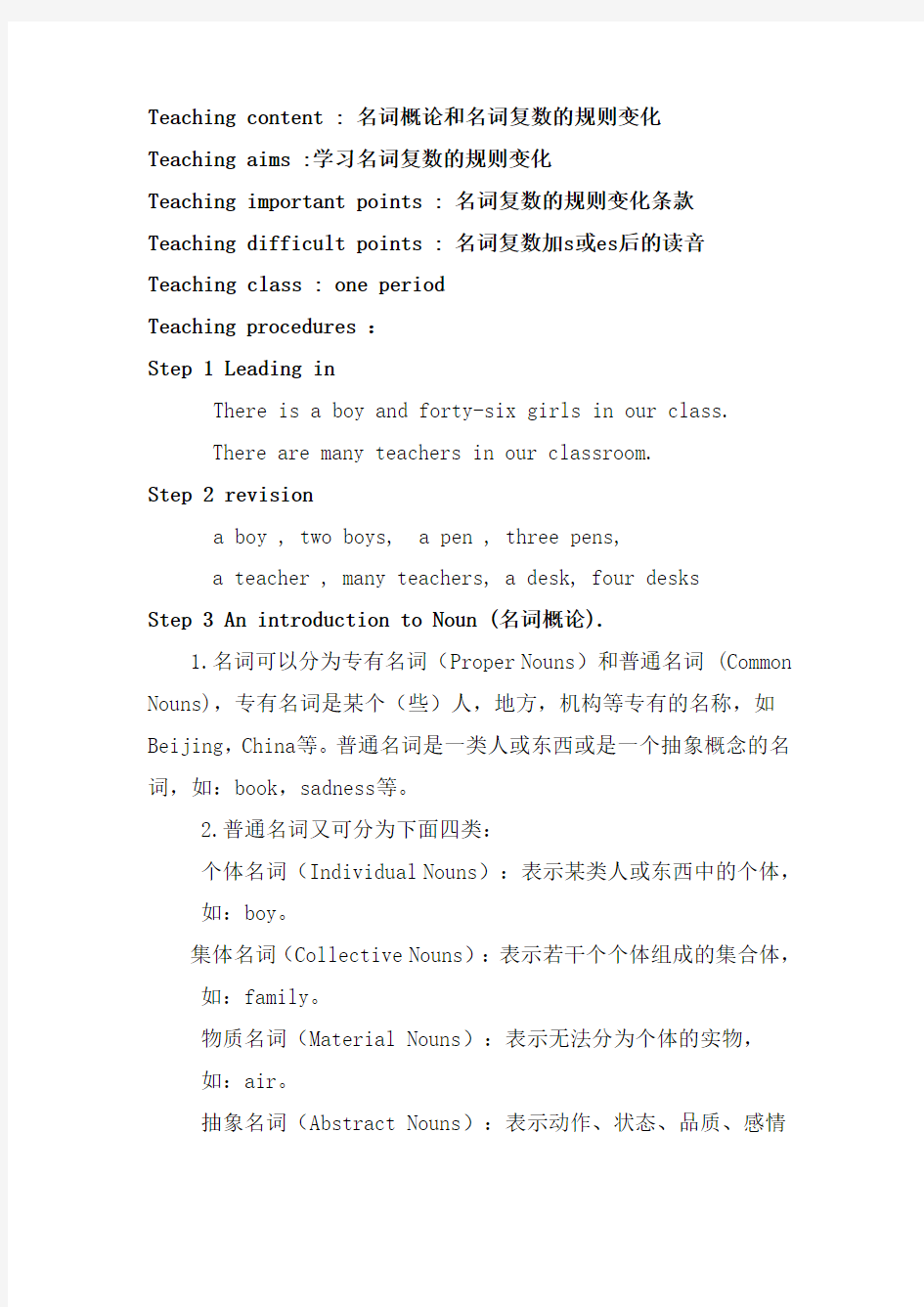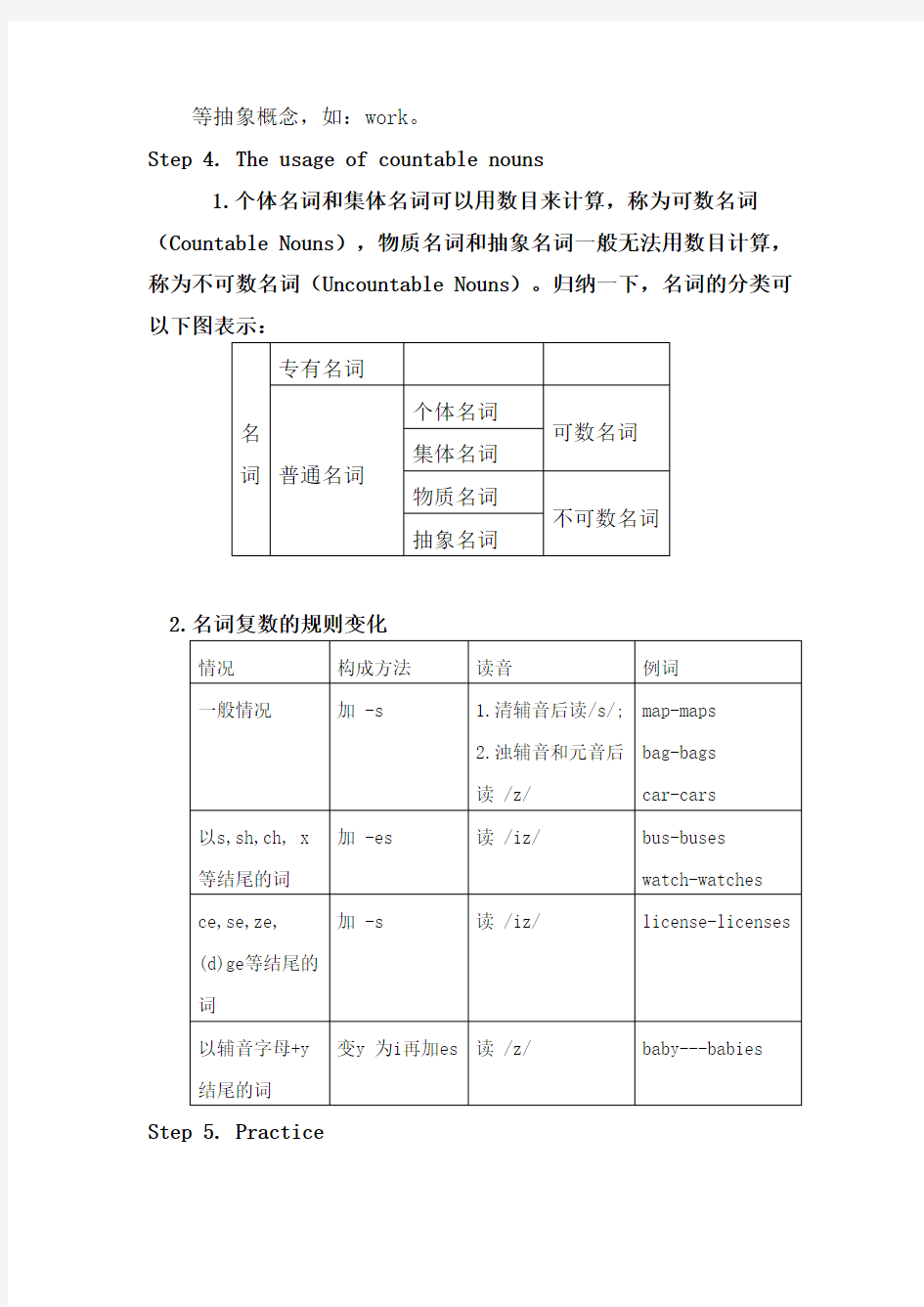

Teaching content : 名词概论和名词复数的规则变化
Teaching aims :学习名词复数的规则变化
Teaching important points : 名词复数的规则变化条款
Teaching difficult points : 名词复数加s或es后的读音Teaching class : one period
Teaching procedures :
Step 1 Leading in
There is a boy and forty-six girls in our class.
There are many teachers in our classroom.
Step 2 revision
a boy , two boys, a pen , three pens,
a teacher , many teachers, a desk, four desks
Step 3 An introduction to Noun (名词概论).
1.名词可以分为专有名词(Proper Nouns)和普通名词 (Common Nouns),专有名词是某个(些)人,地方,机构等专有的名称,如Beijing,China等。普通名词是一类人或东西或是一个抽象概念的名词,如:book,sadness等。
2.普通名词又可分为下面四类:
个体名词(Individual Nouns):表示某类人或东西中的个体,如:boy。
集体名词(Collective Nouns):表示若干个个体组成的集合体,如:family。
物质名词(Material Nouns):表示无法分为个体的实物,
如:air。
抽象名词(Abstract Nouns):表示动作、状态、品质、感情
等抽象概念,如:work。
Step 4. The usage of countable nouns
1.个体名词和集体名词可以用数目来计算,称为可数名词(Countable Nouns),物质名词和抽象名词一般无法用数目计算,称为不可数名词(Uncountable Nouns)。归纳一下,名词的分类可以下图表示:
2.名词复数的规则变化
Step 5. Practice
Class, boy, baby, box, room, watch, bus等Step 6. Homework
熟记名词复数的规则变化
名词单复数教案 名词可分为可数名词和不可数名词 可数名词:可以用来计数的名词,有单数和复数形式,如:desk-desks, apple-apples等 不可数名词:不可以直接用来计数的名词,没有复数形式,只有单数形式,如:some bread, a little milk等 一、可数名词 1. 可数名词复数的规则变化 1)一般名词变复数在其后面加s,如map→maps (地图) 2)以s,x,sh,ch等结尾的词加es,如bus→buses(公共汽车),watch→watches(手 表),box→boxes,dish→dishes(盘子) 3)A.以辅音字母+y结尾的词,变y为i,再加es,如baby→babies(婴儿) B.以元音字母+y结尾的词,直接加s,如monkey→monkeys(猴),holiday→holidays(假期),storey→storeys(楼层); 注意:以y结尾的专有名词变复数时,直接加s,如:two Marys, the Henrys 4)以o 结尾的名词变复数时: A. 表示无生命的加s, 如photo→photos(照片),piano→pianos(钢琴), r adio→radios(收音机), zoo→zoos(动物园) B. 表示有生命的加es,如hero→heroes(英雄),potato→potatoes(土豆),tomato→tomatoes(西 红柿)巧记:英雄爱吃土豆炖西红柿。 特殊:zero→zeros / zeroes。 5)以f或fe结尾的名词变复数时: A. 变f,fe 为v,再加es,如half→halves(一半),knife→knives(刀子),wife→wives(妻 子),life→lives (生命)巧记:小偷(thief)的妻子(wife)用刀子(knife)和树叶(leaf)把狼(wolf)劈成两半(half)。 B. 加s的名词有:belief→beliefs(信念),roof→roofs (屋顶) 特殊:如handkerchief→handkerchiefs / handkerchieves。 Practice: 1. They come from different ______ A. country B. countries C. a country D. countrys 2. How many ______ do you see in the picture? A. tomatos B. tomatoes C. tomato D. the tomato 3. There are some ______ in these _______. A.knifes…pencil-boxes B.knives…pencils-box C.knives…pencil-box D.knives…pencils-boxes 4. _______ are good for our health.
智博教育名词变复数变化规则 1.一般情况下,直接加-s,如:book-books, bag-bags, cat-cats, bed-beds ,pig-pigs ,pear-pears ,ruler-rulers,bag-bags,tree-trees 2.以s. x. sh. ch结尾,加-es,如:bus-buses, box-boxes,fox-foxes brush-brushes, watch-watches,peach-peache,dress-dresses, dish-dishes. 3.以“辅音字母+y”结尾,变y为i, 再加-es,如:family-families, strawberry-strawberries body-bodies,cherry-cherries,特别强调boy复数boys ,toy复数toys(a,e,I,o,u原音字母加y结尾的单词直接加s.) 4.以“f或fe”结尾,变f或fe为v, 再加-es,如: knife-knives,wolf-wolves,wife-wives 5.不规则名词复数: man-men,woman-women,policeman-policemen, policewoman-policewomen, mouse-mice child-children, this-these, that-those, I-we, he,she,it-they foot-feet,.tooth-teeth ,goose-geese. fish-fish, people-people, Chinese-Chinese, Japanese-Japanese 6.不可数名词不加s或es液体类和肉类; tea,offee,milk,soup,coke,juice,beer,water,rain,snow,beef,chicken,fish, mutton.(fish,people,sheep,Chinese,不变化). _
一、请写出下列词的复数形式。: 1,leaf _____2,life_____3,thief ____4,woman_____ 5,child_____ 6,foot_____ 7,watch_____8,diary_____9,day______ 10,man____ 11,this_____12,book_______13,dress______14,sheep_______15,tea____ 16,box___17,strawberry_______18,peach____19,juice____20,water____ 21,milk____22,sandwich______23,paper_____24,rice____25,deer_____ 26,fish_____ 27,city____ 28,tree_____ 29,zoo_____ 30,country _____ 31,tooth____32,boy____33,broom_______34,car____35,horse____ 36,bus_____37,fox____38,branch_____39,baby_____40,family_____ 41,dish ____42,radio____43, photo_____ 44,piano_____ 45,knife____ 46. people____47. mouse_____
1.leaves 2.lives 3. thieves 4.women 5.children 6. feet 7.watches 8. diaries 9.days10. men 11.these12. books 13.dresses 14.sheep15. teas 16. boxes 17.strawberries 18.peaches19. juice 20.water https://www.doczj.com/doc/f61775276.html,k 22.sandwiches23. papers 24.rice25. deer 26.fish 27.cities 28.trees 29.zoos 30.countries 31.teeth 32boys 33.brooms 34.cars35. horses 36. buses 37.foxes38.branches39. babies40. families 41. dishes 42.radios43. photos44. pianos 45.knives46. 47. mice 可数名词变复数形式的规则(小学英语) 1 一般情况,在词尾加-s. desk---desks书桌girl---girls女孩boy---boys pen---pens 2 以-s,-x,-ch,-sh 结尾的词,在词尾加--es bus---buses box--boxes brush--brushes watch--watch 3 以辅音字母加y结尾的词,变y为I,加-es baby-babies婴儿family--families 家庭 4以-f 或-fe 结尾的词,变f 或fe 为v,再加-es knife---knives 刀leaf---leaves 树叶 5 以辅音字母加-o 结尾的词,一般情况下,在词尾加-es tomato---tomatoes 西红柿potato--potatoes 马铃薯 6可数名词变为复数形式的不规则变化如下: foot--feet 脚,mouse--mice老鼠,goose--geese鹅,ox--oxen公牛,man-men男人,woman--women女人,child--children孩子,Chinese--Chinese中国人,deer--deer 鹿,sheep--sheep 绵羊fish--fish 鱼
1 / 31
教学过程 一、课堂导入 老师将下列句子呈现给学生,学生跟着老师读下列句子,并对比前后两句话中划线部分的不同。 1. There are so many boxes on the floor. There are so much water on the floor. 2. I like eating fish. I like keep some different kinds of fish in my fish tank. 2 / 31
可数名词复数变化教案 二、复习预习 教师引导学生复习上节课所学的there be句型的概念,用法,以及there be的一般将来时态等。(以提问、回顾的形式进行),针对上节课的作业进行讲评、订正、答疑,并通过对there be具体用法的分析和扩展导入本节课所要学习的名词的分类,可数名词的复数构成等知识点。 3 / 31
可数名词复数变化教案 三、知识讲解 知识点1:名词的分类 专有名词:主要指人、地方、组织、机构等的专有的名称。专有名词的第一个字母通常大写,如Paris 名词个体名词desk,table,computer 可数名词 集体名词people,police,class 普通名词 不可数名词物质名词water,meat,bread 4 / 31
可数名词复数变化教案 抽象名词imagination,happiness,freedom 5 / 31
可数名词复数变化教案 1. 【考查点】可数名词与不可数名词的区分,不可数名词没有复数形式。通常肉类,液体,面包等时不可数的。 如:There is much water in the bottle. There are 7 days in a week. I’m so hungry. Please give me three pieces of bread to eat. 2. 【考查点】专有名词首字母必须要大写。 如:we go to the Great Wall on Saturday。 6 / 31
一.名词变复数规则 1.一般名词复数是在名词后面加上“s”,如map→maps,bag→bags等; 2.以s,sh,ch,x等结尾的词加“es”,如bus→buses,watch→watches等; 3.以辅音字母+y结尾的词,变y为i加es,如baby→babies等; 以元音字母+y结尾的名词变复数时,直接加s变复数,如monkey→monkeys,ho liday→holidays, 4.以o 结尾的名词变复数时:(1)没有生命的名词加s:如photo→ph otos ,piano→pianos, radio→radios,(2)有生命的名词加es:如potato→potatoes;tomato→tomatoes;hero—heroes 5.以f或fe结尾的名词变复数时:变f或fe为v,再加es 如:leaf ; thief; wolf ; wife ; knife ; life 6.不规则的名词变复数, 如:man ; policeman; woman ; policewoman; child ; foot ; tooth ; mouse ; sheep ; deer ; fish ; Chinese; Japanese 二.动词变三人称单数 1.一般情况加–s 如:make ; stop ; help 2.以s,sh,ch,x等结尾的词加–es 如:dress; pass ; wash ; teach ; watch ; teach ; fix 3.以辅音字母+y 变y 为i结尾的词再加es 如:study ; fly ; try ; carry 以元音字母加y结尾的词,直接加-ed 如:play ;stay ; enjoy ; 4.以“o”结尾的动词,加“es”,如:go ; do 三.动词变现在分词(即-ing形式) 1. 一般情况,加-ing 如:go ; ask ; look ; watch 2. 以不发音的e结尾的动词,去e,再加-ing 如:write ; make ; take; practice ; 3. 以重读闭音节结尾的动词,末尾只有一个辅音字母,双写这个辅音字母,再加-ing 如:get ; sit ; run ; put ; begin ; swim ; stop ; plan ; shop 四.动词变过去式 1. 一般情况,加-ed 如:look ; play ; start ; listen 2. 以e结尾的动词,加-d 如:hope ; use ; live ; decide 3. 以重读闭音节结尾的动词,末尾只有一个辅音字母,双写这个辅音字母,再加-ed 如:stop ; plan; shop 4. 以辅音字母加y结尾的动词,变y为i,再加-ed 如:study ; carry ; worry ; try ;
可数名词变复数形式的规则 英语中的可数名词大多都有单数和复数两种形式,复数形式通常是在单数形式后加-s构成,主要方式是: 1.在名词后直接加-s,如: a book books a cat cats 2.以s, x, ch, sh结尾的名词加es构成复数,如: a bus buses a box boxes a watch watches a dish dishes best wishes 3.以“辅音字母 + y”结尾的名词构成复数时,需将y改为i,然后加复数词尾-es,如: a city cities a country countries 4.以f或fe结尾的名词构成复数时,一般改f为v,然后加-es,如: a knife knives a leaf leaves a thief thieves 例外的词有: a roof roofs a proof proofs a chief chiefs a cliff cliffs a hoof hoofs a gulf gulfs 5.以元音字母o结尾的名词一般加-es词尾构成复数,如: a hero hero es a potato potato es a tomato tomato es 例外的词有: a photo photo s a piano piano s a radio radio s a zoo zoo s 以及bamboo s, video s , kilo s , studio s, cuckoo s等。 6.有些名词复数有不规则变化,如: a m a n men a wom a n women a tooth teeth a foot feet a child children a goose geese a mouse mice an ox oxen 7.有些名词单复数形式相同,如: a sheep sheep a deer deer a Chinese Chinese a swine swine a means means a people people 备注:fish和fruit虽有复数形式,却不表示数量,而表示种类。 名词复数形式还有一些其它情况,需在阅读和学习过程中不断丰富,逐步掌握。
例:ox→oxen; child→children; brother(用于教堂)→brethren 十四、一些单数词得改头换面一番,才能变成复数词 例:analysis→analyses分析; basis→base s基础; datum→data数据; foot→feet; formula公式→formulae/formulas; goose→geese; louse虱子→lice; man→men mouse→mice; medium→media/mediums媒介; emorandum→memoranda/memorandums备忘录; parenthesis→parentheses 圆括号; phenomenon→phenomena现象; radius→radii 半径tooth→teeth; woman→wo men 十五、有些名词是单数、复数不分的 例:deer; fish; cannon(大炮); sheep; salmon 鲑鱼; trout 鳟鱼 十六、一些名词虽分单数、复数,但出现次数多的总是单数词 例:absence; clothing;film; help; furniture家具; machinery机械; news; scenery风景; sugar; traffic交通 十七、另一些名词则以复数词出现的机会较多 例:bellows风箱; clothes; police; shorts短裤; scissors剪刀; spectacles眼镜; shears大剪刀trousers长裤; wages工资 十八、compound nouns,这类复数词是以主要的名词来表示 例:daughter-in-law→daughters-in-law 媳妇; father-in-law→fathers-in-law岳父 man-of-war→men-of-war兵舰; maid-servant→maid-servants 女仆tep-son→step-sons晚子; son-in-law→sons-in-law 女婿 十九、若表达具体数目,要借助数量词 例:pair(对,双); suit(套); a pair of glasses; two pairs of trousers 二十、另外还有一些名词,其复数形式有时可表示特别意思, 例:goods货物,waters水域,fishes(各种)鱼 二十一、除人民币元、角、分外,美元、英镑、法郎等都有复数形式。 例:a dollar, two dollars; a meter, two meters 二十二、合成词单复数变化规则 1)以不可数名词结尾的复合名词无复数形式。例如:homework, newspaper等。 2)以man或woman为前缀的名词变复数时,前后两个名词都变成复数。例如:woman doctor→women doctors, man waiter→men waiters. 3)以“可数名词+介词(短语)”构成的复合名词变复数时,把名词变复数。例如:fath -er in law→fathers in law. 4)以“动词/过去分词+副词”构成的复合名词变复数时,在词尾加s。例如:grown up→ grown ups, stand by→s tand bys. 二十三、集合名词单复数变化 有些名词为单数形式,但做整体概念来看待,称为集合名词或集体名词,如:people police cattle,其谓语动词一般用复数。有些名词为单数形式,做整体概念来看待时,谓语动词用单数。强调整体中具体人或事物时,谓语动词用复数。如:class, family, audience,
名词单数变复数变化规则: 一.可数名词 1.一般名词复数是在名词后面加上“s”,如map→maps,bag→bags,book-books 等; 2.以s,x,sh,ch结尾的词加“es”,如bus→buses,watch→watches, box-boxes 等; 3.以f或fe结尾的名词变复数时,去掉f,fe 加ves的名词有:half→halves knife →knives leaf→leaves wolf→wolves wife→wives life→lives thief→thieves 4.以o 结尾的名词变复数时: a)加s的名词有(无生命):photo→photos ,piano→pianos,radio→radios b)加es的名词有(有生命):potato→potatoes tomato→tomatoes 5.以辅音字母+y结尾的词,变y为i加es,如baby→babies, family-families, study-studies等; 以元音字母+y结尾的名词变复数时,直接加s变复数,如monkey→monkeys,holiday→holidays,storey→storeys(楼层); 6. oo变ee的单词:foot-feet, goose-geese, tooth-teeth; 7. a变e的单词:man-men, woman-women, policeman-policemen; 8. 复数与原形一致的单词:fish-fish, sheep-sheep, deer-deer, Chinese-Chinese, Japanese-Japanese; 注:1.fish指“鱼肉”时,是不可数名词;2.fish指“鱼的多少”时,是可数名词,但单数和复数同行;There are many fish in the river。3.fish强调鱼的“种类“时,复数是“fishes”。There are many kinds of fishes in the river。 9. 有些名词以-s结尾,但表达的是单数意义,例如:news,maths,politics,physics,the United States等。 10. 常以复数形式出现的名词,例如:glasses,trousers,shoes,gloves,socks 等,要表达他们的量时常用pair,例如:a pair of glasses/shoes; 复数只需量词变复数,例如:two pairs of shoes 11. 名词作定语时,不用复数形式,如:a shoe shop。如果要表示复数,则去掉不定冠词,把名词词组中的最后一个名词变成复数形式,如:an apple tree---apple trees
名词单数变复数规则及 练习 标准化管理部编码-[99968T-6889628-J68568-1689N]
名词 1.定义:一般来说,个体名词和集体名词多为 物质名词和抽象名词多为 2.可数名词的数: 一个”时用单数,a bird,a teacher,an apple,表示“多个”时用复数。 two birds,five teachers,eight apples. 3.可数名词复数的变化规则. A、一般情况下,在单数名词的后面加-s构成。如:game-games,boy-boys 等。 B、以s、x、sh、ch结尾的单数名词变复数,在词尾加-es构成。如:box-boxes,bus-buses,peach-peaches,dish-dishes。 C、以o结尾,表示有生命的事物的单数名词变复数加-es;表示没有生命的事物的单数名词变复数加-s。如:potato-potatoes,tomato-tomatoes,photo-photos,piano-pianos等。 D、以辅音字母加y结尾的单数名词变复数,将y改成i后再加-es。如:factory-factories,story-stories,family-families。 E、以f或fe结尾的单数名词变复数,将f或fe改成v,然后再加-es。如:leaf-leaves,life-lives,knife-knives等。 F、名词单数变复数,除了有规则可循的变化之外,还有一部分的变化是不规则的,我们将这部分名词的变化叫做不规则变化。这些词有:goose-
geese,foot-feet,tooth-teech,man-men,woman-women,mouse-mice,sheep-sheep,deer-deer,fish-fish,child-children,ox-oxen 4.不可数名词量的表示 些词计量,我们于是采用这种方法: 如:a cup of tea,a box of milk,a piece of paper等。 如果为了表示多个的概念,我们就将表示这些东西的单位变成复数即可。 如:a cup of tea---3 cups of tea,a box of milk---12 boxes of milk,A piece of paper---100 pieces of paper 名词的练习题 一.写出以下单词的复数. I _________him _________this ___________her ______watch _______child _______photo ________diary ______day________ foot________ book_______ dress ________tooth_______ sheep ______box_______ strawberry _____thief _______yo-yo ______ peach______ sandwich ______man______ woman_______ paper_______ juice___________water________ milk________ rice__________ tea__________ 二、写出下例名词的复数形式 1、monkey __________ 2、boy _______ 3、duck _____ 4、house_________ 5、bus ________ 6、 lady_______ 7、sheep _________ 8、deer ________ 9、 child_____ 10、foot _________ 11、tomato_________ 1 2、ox
教师辅导教案 授课日期:年月日授课课时:课时
诀: 一、二、三,单独记;八去t,九除e,ve要用f替,整十基数变序数,先把ty变成tie;要是遇到两位数,十位基数个位序,th最后加上去。 解析口诀:one→first,two→second,three→third这三个词变化特殊,要单独记;eight→eighth,nine→ninth,八去t,九去e后再加-th;five→fifth,twelve→twelfth,五、十二把ve换成f再加-th;twenty→twentieth,thirty→thirtieth...整十先把词尾y改为ie再加-th。两位数时则十位数用基数词,个位数用序数词,如:twenty-first。 1、第一类:first (1st) 第一; second (2nd) 第二; third (3rd) 第三 (在括号里的是缩写形式,均在阿拉伯数字后面加上相应序数词的最后两个字母构成,以下各类与此相同。)这类序数词只有三个,在整个序数词里面是特殊的,就和第一类基数词一样,需要逐个地硬记下来。 2、第二类: fourth (4th) 第四 fifth (5th) 第五 sixth (6th) 第六 seventh (7th) 第七 eighth (8th) 第八 ninth (9th) 第九 tenth (10th) 第十 eleventh (11th) 第十一 twelfth (12th) 第十二 thirteenth (13th) 第十三 fourteenth (14th) 第十四 fifteenth (15th) 第十五 sixteenth (16th) 第十六 seventeenth (17th) 第十七
可数名词变复数的规则教案 教学目标: 1. 能够理解可数名词的含义。 2. 能够理解可数名词变复数的规则。 3. 能够准确运用可数名词变复数的规则。 教学重难点: 1. 能够理解可数名词变复数的规则。 2. 能够准确运用可数名词变复数的规则。学情分析:学生能够分辨出单词的词性是否属于名词,但对于可数名词和不可数名词的区分,概念上还是有些模糊。特别是对于可数名词复数形式的理解及运用还存在一定问题。 教学步骤: 一. 开课导入: 1. A guessing game:What ' s in the pencil case ? How many _________ in the pencil case? 2. 点题: 二.新授课:(通过PPT呈现) 1. 什么是名词?名词的分类有哪些? 2. 什么是可数名词?它有哪两种形式? 3. 自主学习微课-- 可数名词变复数的规则 4. 组内交流你所记得的可数名词变复数的规则,比比谁记的多?
5. 对子间互相考一考:一人说单词,一人说出对应的复数形式,看谁说对的个数多? 三.巩固操练:名词可数变复数专项练习名词可数变复数专项练习一.写出下列名词复数 leaf _____ box _______ knife _______ fox _____ bus _____ dish _________ ruler _________ glass _______ pencil _______ boy _________ zoo _______ man ________ sheep ______ key ______ story _______ bamboo _______ family _____ day _____ fish_____ goose _______ Chinese ______ deer ______ foot _____ child _______ tooth _____ hero _______ boss ___ monkey ______ 二.用所给的单词的复数的正确形式填空:1>I have two (pencil-box). 2>There are three _____ (chair) in the classroom. 3>These ______ (tomato) are red. 4> ____ (hero) are great. 5>My brother looks after two ____ (baby) 6>There are some _____ (deer) eating the grass. 7>My father likes to eat _____ (potato). 8>Chinese ____ (people)like to eat noodles. 9>I have a lot of _____ (toy) in my bedroom.
英语名词复数的规则变化 英语中名词可分为可数名词和不可数名词。可数名词在应用时有单数和复数形式。表示一个用单数,表示两个或两个以上用复数。复数名词的构成分为规则变化和不规则变化。 一、规则变化: 1、一般在名词词尾加s, ①map—maps地图,bird—birds鸟, orange—oranges 桔子, bike—bikes自行车; 2、以s, x, ch, sh结尾的名词加es, ①box—boxes盒子,class—classes班级,watch—watches手表,dish-dishes盘,碟子,餐具; 3、以O结尾的名词后面加s或es ①photo—photos相片radio—radios收音机zoo—zoos动物园tomato—tomatoes西红柿potato—potatoes土豆 4、以辅音字母加y结尾的名词,变y为i+es ①baby—babies婴儿family—families家庭; 以元音字母加y结尾的名词直接加s ①boy—boys男孩toy—toys 玩具; 5、以fe或f结尾的名词,把fe或f变为ves ①knife—knives小刀 wife—wives妻子 leaf—leaves树叶。 二、名词复数的不规则变化 1、child---children foot---feet tooth---teeth mouse---mice man---men woman---women 注意:与man 和woman构成的合成词,其复数形式也是-men 和-women。 如:an Englishman,two Englishmen. 但German不是合成词,故复数形式为Germans;Bowman是姓,其复数是the Bowmans。2、单复同形如:
-----好资料学习 小学英语名词复数复习课教学设计 临川八小占小芳 教学内容与目标:、复习名词复数。1 教学重点、难点:能灵活运用名词复数。课前准备:多媒体课件教学过程一、热身活动1.Free talk. new teacher today. Look, T: Hello! I am Miss Zhan. I'm yourthere are many teachers here. How many teachers can you see? 热身,引出Let's say hello to the teachers. 师生问好,回答问题。 .。话题2. Let's chant.设计意图:通过简单上口的说唱,调动学生的英语思维,为课堂做好准备,同时通过小歌谣里单复数名词的对比使学生初步接触名词复更多精品文档. 好资料学习-----数,感受单复数的变化二、整体梳理再现。梳理词汇。 1.T: There are 2 boxes. Look, this is the wisdom box. This is the health box. There are things that can help our study in the 生猜与学习有关的东wisdom box. What are they? Please guess. () 西如学习用品等T: You know so many things. Wonderful! Let's
open it and see. there are) 呈现主要句型结构:(T: What about the health box? There are things that can make 生猜有关身体健康的东西如水us healthy. Guess what are they? () 果等You are so smart. Let's open the box.:T设计意图:通过猜箱子里的东西,将学生的头脑激活,进行第一次头脑风暴,使学生将学过的名词进行回顾) 2.呈现智慧先生和健康先生。A:Great! There are so many interesting things in the boxes. T:Whose boxes are these? the has ) here Look, they come. (呈现智慧先生Mr Wisdom wisdom box, and Mr Health has the health box. They have so the Read happy. are but wonderful boxes, they not Why? 更多精品文档. 好资料-----学习passage and find the answer. Mr wisdom is a teacher. He has many students from different classes. They all love him. He likes colleting leaves and eating has like candies. But he doesn't peaches and tomatoes. He many friends, because he is very smart. But he is not happy, His because he is often hurt. His not healthy(健康的). teeth neighbour is Mr health. He likes potatoes and apples. He can drive buses. He is very healthy, but he is not happy. Because
名词单数变复数规则 名词是表示人、事物、地方、现象及其他抽象概念名称的词。 1.名词分为专有名词和普通名词。 如:Guangzhou,Mike,UNESCO等。 专有名词一般情况下第一个字母要大写,前面不加定冠词the。 如:police,eggs,rice等。 普通名词又可分为个体名词、集体名词、物质名词和抽象名词。 个体名词:表示某一类人或某一类东西中的个体。如:monkey,panda,ruler,boy等。 集体名词:表示一群人或一些事物的总称。如:family,police,class,people等。 物质名词:表示无法分为个体或不具备确定形状和大小的实物。如:Water,air,milk等。 抽象名词:表示抽象概念词。如:hope,love,spirit。 在讨论名词的数之前,必须了解英语的名词有可数名词和不可数名词两种。 一般来说,个体名词和集体名词多为可数名词,物质名词和抽象名词多为不可数名词。 不可数名词: 不可数名词意味着这些名词只能是单数,没有复数形式,不能与数目字如one, two等连用,也不能加不定冠词a(n)。不可数名词没有单数、复数之分,但我们在生活中有时候又必需给这些词计量,我们于是采用这种方法: 如:a cup of tea,a box of milk,a piece of paper等。 如果为了表示多个的概念,我们就将表示这些东西的单位变成复数即可。 如:a cup of tea---3 cups of tea,a box of milk---12 boxes of milk,A piece of paper---100 pieces of paper *需要注意的是,a.当物质名词转化为个体名词时为可数。比较:Cake is a kind of food.蛋糕是 一种食物。(不可数)These cakes are sweet.这些蛋糕很好吃。(可数)b. 当物质名词表示该物质的种类时,可数。例如:This factory produces steel.(不可数)We need various steels.(可数)c. 当物质名词表示份数时,可数。例如:Our country is famous for tea. 我国因茶叶而闻名。Two teas, please. 请来两杯茶。 2)抽象名词表示具体的事例时也可数。例如: four freedoms 四大自由 the four modernizations四个现代化 只有可数名词才有单数和复数两种形式。 一、绝大多数的可数名词的复数形式,是在该词末尾加上后辍-s。 例:f riend→friends; cat→cats; style→styles; sport→sports; piece→pieces 二、凡是以s、x、ch、sh结尾的词,在该词末尾加上后辍-es构成复数。
英语可数名词的复数变化规则: 1、一般情况下加S 例如: book——books ruler——rulers hen——hens 2、以s、x、ch、sh 结尾,加es 例如: } bus——buses box——boxes watch——watches dish——dishes 3、以元音字母+y结尾,加s (元音字母:a o e i u) 例如: monkey——monkeys holiday——holidays , toy——toys 4、以辅音字母+y结尾,去掉y,加ies 例如: story——stories baby——babies ①直接加s
5、以f、fe结尾有的②去掉f或fe,加ves ③既可以直接加s,又可以去掉f、fe加ves ( 以f、fe结尾,直接加s 顺口溜:海湾农奴信酋长,悬崖证据在房顶。 gulf——gulfs[ɡ?lf]海湾 serf——serfs[s??f]农奴、奴隶 belief——beliefs[b?'li?f]信 chief——chiefs [t?i?f]酋长 cliff——cliffs[kl?f] 悬崖 proof——proofs[pru?f]证据 】 roof——roofs[ru?f]房顶 以f、fe结尾,加es 顺口溜:妻子持刀去宰狼, 小偷吓得发了慌, 躲在架后保己命, 半片树叶遮目光。 wife——wives[wa?f] 妻子 — knife——knives[na?f] 小刀 wolf——wolves[w?lf] 狼 thief——thieves[θi?f]小偷
shelf——shelves[?elf] 架子 self——selves[self] 自己 life——lives[la?f] 生命 half——halves[hɑ?f]一半 leaf——leaves[li?f]树叶 ; 注:关于self的复合词,也是去掉f加ves 例如: myself——ourselves yourself——yourselves himself(herself)——themselves 以f、fe结尾,既可以直接加s,又可以去掉f、fe加ves 顺口溜:码头侏儒围围巾,手绢复数变二心。 例如: 、 Wharf [w??f]码头 Dwarf [dw??f]侏儒 Scarf [skɑ?f]围巾 Handkerchief ['h??k?t??f] 手绢 6、以O结尾的一般有两种情况,但是也有特殊情况。 一般无生命的加s 例如: auto——autos['??t??] 汽车 ·
可数名词变复数规则总结 英语名词单数变复数主要有以下规则: 一、绝大多数的可数名词的复数形式,是在该词末尾加上后辍-S。读音变化:结尾是清辅音读[s],结尾是浊辅音或兀音读[z]。 例: friend —friends; cat —cats; style —styles; sport —sports; piece —pieces 二、凡是以s、z、x、ch、sh结尾的词,在该词末尾加上后辍-es构成复数。读音变化:统一加读[iz]。 例: bu厂buses; quiz —quizzes; fox —foxes; match —matches; flash —flashes box —boxes; watch —watches; actress —actresses; class —c(s长途车oach —coaches; dress —dresses; sandwich —sandwiches; toothbrush —toothbrushes; waitress (女侍者)—waitresses 三、以辅音字母+y结尾的名词,将y改变为i,再加-es。 读音变化:加读[z]。 例: candy—candies; daisy (雏菊)—daisies; fairy —fairies; lady —ladies; story —stories strawberry —strawberries; baby —babies; puppy —puppies; library —libraries; dictionary —dictionaries; cherry —cherries; activity —activities 四、以-o结尾的名词,如果不是外来词或缩写,就加-es,否则加-s构成复数。(有生命的加es 无生命的加s) 读音变化:加读[z]。 例: tomato^tomatoes; potato —potatoes; torped鱼雷)—torpedoes; bing(彩票式游戏)—bingoes 反例:silo (青贮塔)—silos; piano —piano外卜来词);photo —photos; macro (宏指令,计机算语言)—macros (缩写词) 五、以-f或-fe结尾的名词,多为将-f或-fe改变为-ves,但有例外。读音变化:尾音[f]改读[vz]。 例: knife —knives; life —lives; leaf —leave员工ia—staves; sca(围巾) —scarves 目前搜集的直接加s:roof-roofs, belief-beliefs,gulf(海湾)-gulfs, serf (农奴)-serfs safe-safes,chie(负责人)-chiefs 这几个可变可不变:scarf-scarfs handkerchief- handkerchiefs